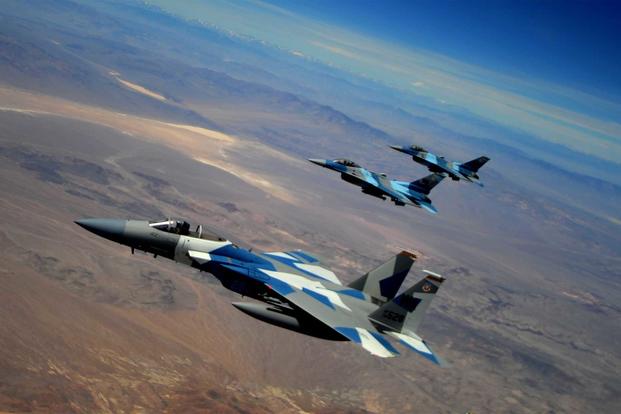Move over, Watson.
An artificial intelligence algorithm this month beat a human fighter pilot during a simulated dogfight, DARPA officials revealed. This human-machine showdown comes as the military puts more of its pilots in a digital cockpit, rather than a physical one, for qualifications and training.
During the Defense Advanced Research Projects Agency-hosted AlphaDogfight challenge last week, Maryland-based Heron Systems came in first place among eight companies who pitted their AI-powered simulated aircraft against one another for two days straight. Then, Heron's system on the third day beat an F-16 Fighting Falcon pilot "in five straight simulated dogfights in the man-vs-machine finale," the organization said following the finals.
Read Next: This New Air Force Training Center Will Prep Pilots for War with China and Russia
The companies that took part were Aurora Flight Sciences, a subsidiary of Boeing Co.; EpiSys Science; Georgia Tech Research Institute; Heron Systems; Lockheed Martin Corp.; Perspecta Labs; PhysicsAI; and SoarTech. The trial took roughly a year to plan, DARPA officials said.
Heron beat Lockheed for the top spot among the companies, according to Col. Dan "Animal" Javorsek, DARPA program manager for the event and former F-16 pilot. Aurora, Heron Lockheed and PhysicsAI were among the finalists.
Heron's tactics throughout the three-day competition, such as an "aggressive gun maneuver," gave them the upper hand, Javorsek said during a live-stream on YouTube.
The AI-powered aircraft used other confrontational moves during the simulation, such as directly flying toward one another at a close, 100-foot range without letting up until the last possible second -- a high-stakes game of chicken.
But these maneuvers went beyond the scope of how human pilots train to face off at the elite Air Force Weapons School -- the service's version of Top Gun -- at Nellis Air Force Base, Nevada, Javorsek said.
"We're performing complex physics in a dynamic environment," added Banger, the F-16 pilot who squared off against Heron in the final round. The pilot was only identified by his call sign.
"I'm trying to solve for angles and different closures, airspeed differences, etc., to arrive at a position where I can employ my weapon or whatever I choose [to employ] onto an enemy aircraft," Banger said during a phone call with reporters.
The fighter pilot's goal is to maximize the jet to arrive at a point where it can shoot to win the fight, he said.
But the AI ultimately secured its victory without allowing Banger the chance to fire back. He was forced to use all his time on evasive maneuvers, he said, which were ultimately unsuccessful.
Javorsek said AI algorithms cannot totally replicate the way pilots train or get ready for a head-to-head fight with enemy aircraft or new threats posed from adversaries such as Russia or China. But employing an AI adversary -- a system that learns and self-corrects in real-time -- will make pilots more aware of how they can and should think differently while up in the air.
"When you look at these artificial intelligence games that are played ... what you find is that the artificial intelligence community has been experimenting with what started in board games [such as] chess, 'Go,' and very rapidly within the last 10 years moved [these strategies] into real-time video games," Javorsek said, recapping the first two days of the competition.
While chess is a battle focusing on maneuvers to eliminate the king, Weiqi, more commonly known as Go, forces the player to focus on position, encirclement and counter-encirclement.
Training with AI may also give human pilots more confidence in the technology down the road, particularly as the Pentagon looks to pair manned fighters with algorithm-driven "Loyal Wingman" drones, he said.
"That's what we really tried to leverage in what we designed here," Javorsek said.
AI has been successful before in battle simulations: During an aerial demonstration in 2016, a program dubbed Alpha proved its worth during a simulated wargame using "mixed combat teams of manned and unmanned air fighters to operate in highly contested environments."
The DARPA experiment falls into the agency's larger Air Combat Evolution (ACE) program, which aims to automate some air-to-air combat training in the future.
The increased focus on simulation comes as military leaders, particularly in the Air Force, work to overhaul the pilot training curriculum and augment flight hours with virtual reality training on the ground.
Air Education and Training Command last month introduced a simulator-heavy experiment, known as UPT 2.5, at some of its training bases.
If successful, the service will then gradually cut back its use of the T-1 Jayhawk, the aircraft used for advanced training of student pilots learning to fly cargo, tanker or command-and-control aircraft, in favor of the simulator-only course.
-- Oriana Pawlyk can be reached at oriana.pawlyk@military.com. Follow her on Twitter at @Oriana0214.
Related: Air Force 1st Lieutenant Beats 4-Star Dad in Livestreamed Dogfight Game














